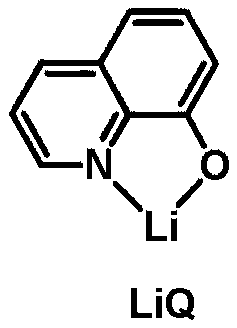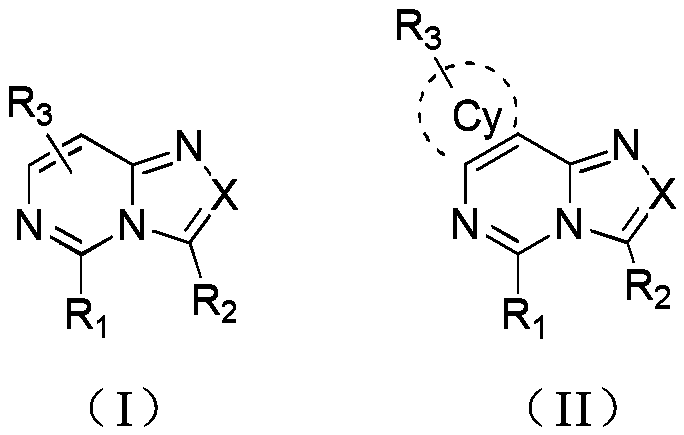Compounds and organic electroluminescent devices
An electroluminescence device and compound technology are applied in the application field of the compound in the field of organic electroluminescence display and lighting technology, and can solve the problems of reducing the recombination probability, increasing the working voltage of the device, reducing the luminous efficiency of the device, and the like
- Summary
- Abstract
- Description
- Claims
- Application Information
AI Technical Summary
Problems solved by technology
Method used
Image
Examples
preparation example Construction
[0119] Preparation of intermediate M1 :
[0120]
[0121] Using 2,4-dichloropyrimidine (or its derivatives) as the starting material, first react with hydrazine hydrate to replace the 4-position chlorine atom with relatively high activity of 2,4-dichloropyrimidine (or its derivatives) to generate Intermediate A. Intermediate A further condenses with aldehyde to remove a molecule of water to generate intermediate B. Intermediate B reacts with iodobenzene acetate for oxidative ring closure to generate the first type of intermediate M1.
[0122] Preparation of intermediate M2 :
[0123]
[0124] Using 2,4-dichloropyrimidine (or its derivatives) as the starting material, first react with ammonia water to replace the highly active 4-position chlorine atom of 2,4-dichloropyrimidine (or its derivatives) to generate intermediate C . Intermediate C is further reacted with α-bromo(hetero)aryl or alkyl ethyl ketone to generate the second type of intermediate M2.
[0125] Th...
Embodiment 1
[0126] Example 1: Preparation of compound 1-121
[0127]
[0128] Preparation of Compound 1-1
[0129] After dissolving 2,4-dichloropyrimidine (500g, 3.38mol) in 10L ethanol in a flask, hydrazine hydrate (634g, 10.14mol, 80% aqueous solution) was added dropwise at 5°C under stirring, and the dropping process kept the temperature below 10°C. After the dropwise addition, the mixture was naturally raised to room temperature for 1 hour, and the precipitated solid was filtered with suction, washed with water and ethanol respectively, and dried in the air to obtain compound 1-1 (389 g, 80%) as an off-white solid.
[0130] Preparation of compound 1-2
[0131] Compound 1-1 (144g, 1mol) was added to a flask containing 1.5L of ethanol, and benzaldehyde (138g, 1.3mol) was added dropwise under stirring at room temperature. After the addition was complete, stirring was continued for 30 minutes, and the obtained solid was filtered and washed with ethanol and Rinse with n-hexane and dr...
Embodiment 2
[0138] Example 2: Preparation of compound 1-124
[0139]
[0140]
[0141] Preparation of compound 2-1
[0142] The compound 5-bromo-2,4-dichloropyrimidine (45.2g, 200mmol) was added into a flask containing 500mL of ethanol, and hydrazine hydrate (37.5g, 600mol, 80% aqueous solution) was added dropwise at 5°C under stirring. Keep the temperature below 10°C. After the dropwise addition, the mixture was naturally raised to room temperature for 1 hour, and the precipitated solid was filtered with suction, washed with water and ethanol, and dried in the air to obtain compound 2-1 (33.3 g, 75%) as an off-white solid.
[0143] Preparation of compound 2-2
[0144] Compound 2-1 (33.3g, 0.15mol) was added to a flask containing 350mL of ethanol, and benzaldehyde (20.7g, 0.2mol) was added dropwise under stirring at room temperature. Rinse with ethanol and n-hexane, and dry to obtain compound 2-2 (28 g, 60%) as a yellow solid.
[0145] Preparation of compound 2-3
[0146] Com...
PUM
| Property | Measurement | Unit |
|---|---|---|
| Molecular weight | aaaaa | aaaaa |
Abstract
Description
Claims
Application Information
 Login to View More
Login to View More - R&D
- Intellectual Property
- Life Sciences
- Materials
- Tech Scout
- Unparalleled Data Quality
- Higher Quality Content
- 60% Fewer Hallucinations
Browse by: Latest US Patents, China's latest patents, Technical Efficacy Thesaurus, Application Domain, Technology Topic, Popular Technical Reports.
© 2025 PatSnap. All rights reserved.Legal|Privacy policy|Modern Slavery Act Transparency Statement|Sitemap|About US| Contact US: help@patsnap.com



